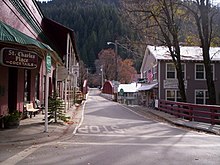State Scenic Highway System (California)
[3] For a highway to then be declared scenic by Caltrans, the local government with jurisdiction over abutting land must adopt a "scenic corridor protection program" that limits development, outdoor advertising, and earthmoving, and Caltrans must agree that it meets the criteria.
The desire to create such a designation has at times been in conflict with the property rights of abutters, for example on State Route 174.
[4][5] Any county highway that is believed to have outstanding scenic qualities is considered eligible, and the county with jurisdiction must follow Caltrans' same approval process as state highways to be declared scenic.
They must not at time of designation be traversed by more than 40,000 vehicles per day on an annual daily average basis.
They also must be "bounded on one or both sides by federal, state, or local parkland, Native American lands or monuments, or other open space, greenbelt areas, natural habitat or wildlife preserves, or similar acreage used for or dedicated to historical or recreational uses".

























